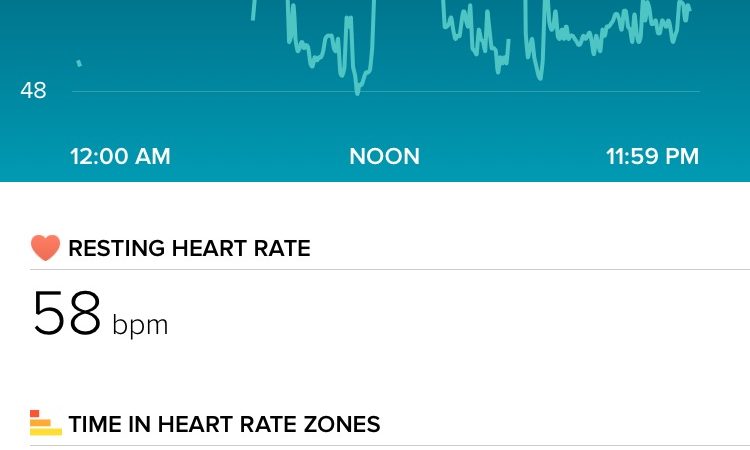What Does this Screen Even MEAN?

 Hi friends!
Hi friends!
I recently had a client ask me what the heart rate tracker screen meant to her and her fat loss on the fit bit. She was confused as to where her targets should be.
Should she be working super hard and getting her heart rate in the “peak zone” as much as possible?
Should she be staying in the “fat burning zone”? After all……she really does want to burn that fat!
Well let’s see if we can break it down, so that you have a better idea of what your goals should be, and the best way to reach them.
First, I’ll explain the three “Zones”
The “Peak Zone “
This is the highest intensity. It’s about 80%-90% of your max heart rate. An estimate for your Max heart rate can be calculated by taking your age away from 220.
So for me, 220-43=177. 80% of 177 =141.6 and 90% of 177= 159.3. Therefore my peak zone is from 141-159 bpm.
This equation is not the most accurate. There are other equations that include information such as your resting heart rate, but for the most part it’s a good indicator of your needs.
This zone is where you will find workouts such as HIITs, or other interval training. Generally, we don’t stay in the peak zone for very long, we dip in and out of it. Sprint work, plyometrics, full body exercises such as thrusters, will all help you reach that peak zone.
The “Peak Zone” is where you will use the anaerobic energy system, burn the most calories, and improve your VO2 max.
The “Cardio Zone”
This is moderate intensity. When you are in the cardio zone you feel like you’re working pretty hard, but you can still talk and carry on a conversation. You’ll be working at 70%-80% of your Max HR. Let’s do the math for me:
220-43 years=177, 70% of 177 = 123.9 and 80% =141.6. So my cardio zone is from 124-142 bpm.
Cardio zone can of course be found doing traditional walks, jogs, and cycle classes. However, you can also reach cardio by lifting with large muscle groups or full body exercises. For example, boot camp classes are a great way to get cardio and resistance work simultaneously. Most bootcamp classes will even dip into the Peak zone throughout the class.
The “Cardio Zone” uses your aerobic energy systems. This means that it is more sustainable than the peak zone, and can be held for much longer. So you burn a few less calories per minute than in peak, but you can maintain the activity.
The “Fat burning Zone”
Ok. So this is the one that causes confusion. The fat burning zone is low intensity work. It is between 60% and 70% of your Max HR. You should feel like you could stay in the fat burning zone for a REALLY LONG TIME. In years past, because it was called fat burning zone, we were told to try to stay at this level for the most weight loss effect. We know now, that it doesn’t quite work that way. In this zone, you do in fact use more fat as fuel. However, just like in nutrition, it’s still all about calories. You burn the most calories in the Peak zone. That’s the bottom line…that’s what makes Peak Zone a much more efficient workout than anything in the fat burning zone.
220-43 years= 177, 60% of 177 = 106.2. My “Fat burning Zone” is 106-124 bpm.
Your Fat burning zone can be reached by daily activity. You are probably in the FBZ when you are cleaning your house, taking your dog for a walk, and taking laundry up and down stairs. Standing up and being energetic will generally lift your heart rate to Fat burning zone.
OK Great. So what is my goal?
A good exercise program will include all three of these zones in their week. A solid combination of exercises and modalities should keep you from overdoing, or under working.
A week example:
2 HIITs @ 30 min and 2 endurance cardio sessions @ 60 min plus a nice long walk on a Saturday morning would easily meet your Peak, Cardio, and Fat Burning needs for the week. Of course, this is just your cardio information….resistance training is additional 🙂
I hope this helped clear things up when you look at that heart rate screen! Just remember, your main goal is to increase the minutes in all three zones. So get up and get moving!!
Remember, you can contact me anytime if you need more help or a more personal/customized schedule! jill@oaklandfit.com